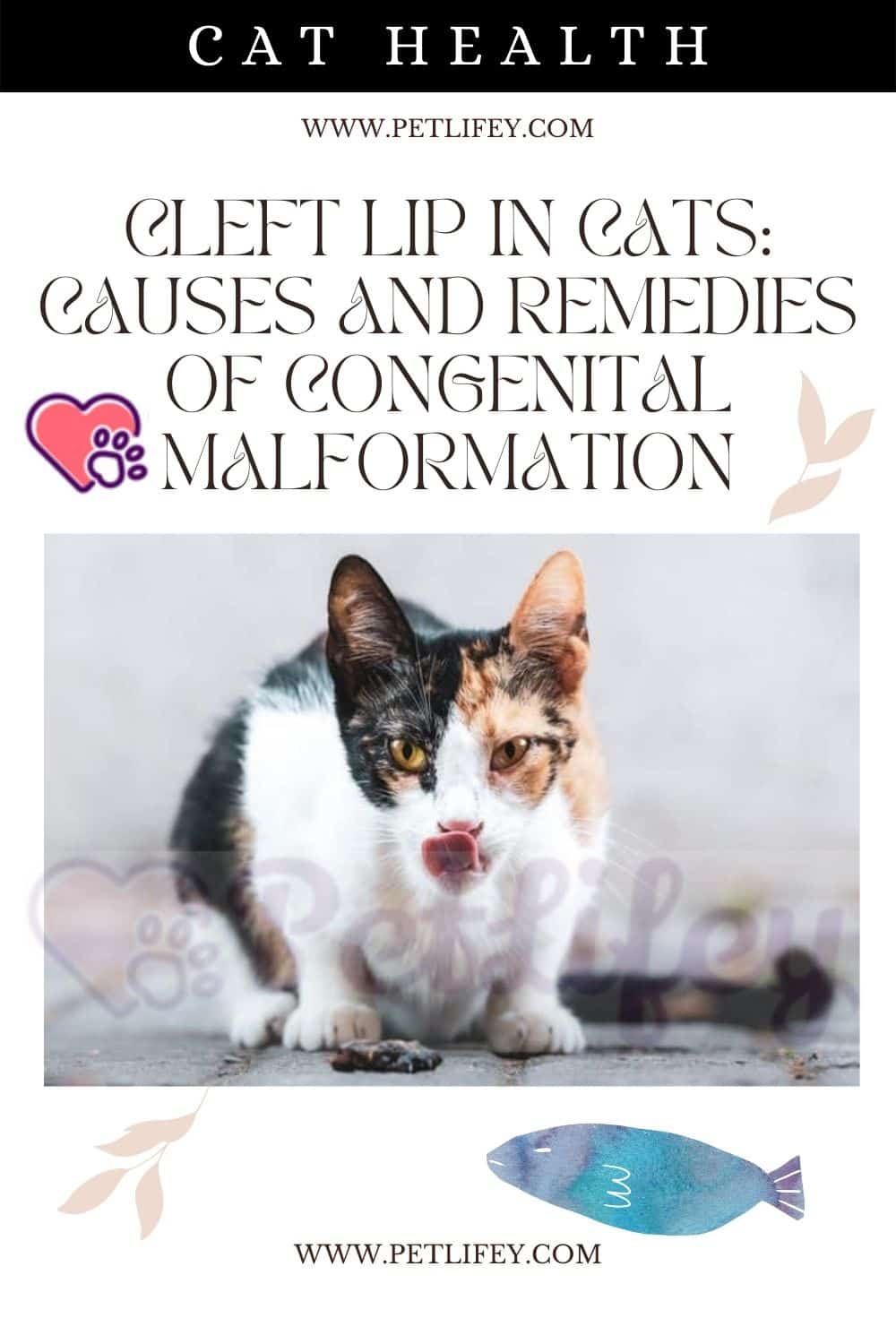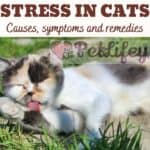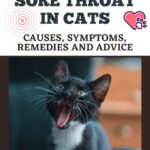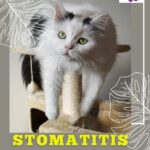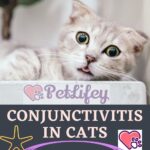Cleft Lip in Cats: Understanding and Managing Feline Congenital Malformations

A cleft lip is a congenital malformation that can be observed in cats, characterized by an opening or split in the upper lip. This condition can range from a small notch in the lip to a large opening that extends into the nose and can affect one or both sides of the lip. It occurs when there is a failure in the normal fusion of the mouth and nasal cavity during embryonic development, potentially leading to difficulties with feeding and susceptibility to infections.
Your understanding of the causes of a cleft lip in cats is crucial for mitigating this condition. Although the exact cause is not always known, it’s recognized that both genetic and environmental factors play roles. Genetics can influence the likelihood of this trait, as it can be inherited from parents with the malformation. Environmental factors, such as exposure to certain drugs, chemicals, or nutritional deficiencies during pregnancy, may also contribute to the development of cleft lips in kittens.
Remedies for a cleft lip in cats aim to ensure the well-being of the affected kittens and prevent the condition’s transmission to future generations. While surgical correction is possible, it typically occurs several months after birth to allow the kitten to grow. In the interim, special feeding techniques, such as using a bottle or tube, are necessary to maintain proper nutrition. To prevent the passing on of this trait, it is generally recommended to spay or neuter cats with the condition.
Understanding Cleft Lip in Cats
Your awareness of cleft lip and palate in cats is essential for early recognition and management of this condition affecting the feline oral cavity.
Defining Cleft Lip and Palate
Cleft lip in cats is a birth defect where there is a physical split or separation in the upper lip, whereas a cleft palate involves a split in the roof of the mouth, which includes both the hard palate (front of the mouth) and the soft palate (back of the mouth). Together, these conditions can affect not just the appearance of your cat but also their ability to eat and breathe properly.
Prevalence and Types
These malformations can vary from mild, involving only a small part of the lip, to severe, where the cleft extends through the entire palate into the nasal cavity. Although the exact incidence rate is not widely reported, they are recognized as significant congenital malformations in the feline population.
The Anatomy of Cleft Malformation
The anatomy of a cleft malformation can range from a small notch in the upper lip to a large gap that extends into the oral cavity and nasal passages. This can lead to complications, such as difficulty nursing in kittens and the potential for aspiration pneumonia due to food and liquids entering the respiratory passages.
Breeds Most Affected
Certain purebred cats, including Siamese, Persian, and a few other breeds, show a higher predilection for these conditions. It’s important for breeders and owners of these cats to be particularly vigilant for signs of cleft conditions, as early intervention can greatly improve outcomes.
Causes of Cleft Lip in Cats
Cleft lip in cats is a congenital defect with various causes, primarily stemming from genetics and environmental factors. Understanding these causes helps in prevention and management strategies.
Genetic Factors
Your cat’s genetic makeup is a significant factor in the development of cleft lip. This condition can be inherited, meaning if one or both parent cats carry the gene responsible for cleft lip, they can pass it on to their offspring. This genetic predisposition doesn’t guarantee that kittens will have a cleft lip, but it does increase the risk significantly.
Environmental Influences
Environmental factors during the critical stages of pregnancy can adversely affect your cat’s kittens. Exposure to harmful chemicals or medication can disrupt normal development. It’s important to ensure that a pregnant cat lives in a safe, toxin-free environment.
Nutritional Deficiencies
Proper nutrition is crucial for the developing embryos. Deficiencies in certain nutrients, notably vitamin A, have been associated with the formation of cleft lips in developing kittens. You should provide a pregnant cat with a balanced diet formulated for growth and reproduction to help prevent developmental defects like cleft lip.
Diagnosing Cleft Lip and Related Issues
In diagnosing cleft lip in cats, your veterinarian will perform a series of specific evaluations to determine the presence and extent of the congenital malformation. This will typically involve an initial physical examination, followed by advanced diagnostic techniques when necessary.
Initial Examination
Your veterinarian will start the diagnostic process with a thorough physical examination of your cat. They will look for visible signs of a cleft lip, abnormal facial structure, or associated issues within the oral cavity. Symptoms such as difficulty nursing, nasal discharge, and respiratory noises can be indicative of a cleft involving the hard and soft palates.
Advanced Diagnostics
If the physical examination suggests a cleft palate or more complex issues, your veterinarian may recommend advanced diagnostic tests. These might include detailed imaging to assess the condition of the tissues and bone structure around the oral cavity. Identifying the precise location and severity of the cleft is critical for determining the appropriate treatment.
Role of X-Rays and Bloodwork
X-rays can provide a clear image of the bone structure of the jaw and palate, revealing any misalignment or gaps in the tissue. They are vital in assessing the extent to which the hard palate is involved. Bloodwork is also an important diagnostic tool, as it can rule out additional health problems that might complicate the cat’s condition or affect the surgical outcome. It’s essential to ensure the cat is healthy enough for potential corrective surgery.
Remember, a timely diagnosis by a qualified veterinarian can significantly improve the prognosis for cats with cleft lip and related issues.
Treatment Options for Cleft Lip
To address a cleft lip in cats, treatment typically involves surgical intervention, supportive nursing care during non-surgical management, and meticulous postoperative care to promote healing and recovery.
Surgical Correction
Surgical correction is generally recommended to permanently resolve a cleft lip in cats and is ideally performed when your cat is stable and has reached an adequate size, often at several months of age. Anesthesia will be required, and your veterinarian will perform surgical repair to close the defect. The timing of the surgery is crucial, as it allows for proper growth and development.
- Pre-surgery: Your cat will undergo a thorough examination to ensure it’s fit for anesthesia and surgery.
- Surgery: The procedure involves the careful alignment and suturing of the separated tissues to create a normal lip contour.
- Post-surgery: Recovery involves monitoring, pain management with appropriate medications, and protection of the surgery site.
Non-Surgical Management
In some cases, particularly when kittens are too young or small for surgery, non-surgical management is necessary to support the cat until they are ready for surgical correction.
- Feeding: Tube feeding may be required to ensure proper nutrition and prevent aspiration pneumonia.
- Hygiene: Regular cleaning of the cleft area prevents infection.
- Monitoring: Close observation for signs of respiratory difficulty or failure to thrive is essential.
Postoperative Care
After surgical correction of a cleft lip, your cat will need attentive postoperative care to ensure a successful recovery.
- Medications: Your vet may prescribe antibiotics to prevent infection and drugs to manage pain.
- Feeding: Special feeding strategies may be necessary until the repair site heals; using a feeding tube may continue for a short period post-surgery.
- Careful Monitoring: You’ll need to closely observe the surgery site for signs of healing or complications, and follow-up visits to the vet are crucial to monitor progress.
Complications and Prognosis
Cleft lip in cats can lead to significant health challenges, but with proper management, the long-term outlook can be positive. Here, you’ll explore the acute and ongoing complications associated with the condition and what factors influence your cat’s prognosis.
Acute Complications
The primary concerns following the diagnosis of a cleft lip are related to feeding and respiratory infections. Infections such as aspiration pneumonia occur when food or liquids are inhaled into the lungs, a risk heightened by the abnormal connection between the mouth and nasal passages. Immediate symptoms may include difficulty breathing or chronic cough.
Long-Term Challenges
Over time, a cleft lip can lead to chronic respiratory infections and problems with teeth and enamel due to the misshapen jaw and oral cavity. This malformation can also affect your cat’s ability to eat properly, often resulting in weight loss. The abnormality in the bony portion of the mouth, specifically where the split or opening exists, may also require surgical correction to improve functionality and quality of life.
Prognostic Factors
The prognosis for a cat with a cleft lip depends on several factors:
- Severity of the split: Affects both treatment options and the potential for full recovery.
- Involvement of the palate: The more extensive the malformation, the higher the risk of complications.
- Age and overall health: Younger, healthier cats typically recover more effectively from surgical interventions if needed.
- Care quality: Consistent, attentive care including specialized feeding techniques and monitoring for signs of respiratory infections can greatly improve outcomes.
Your cat’s prognosis is determined by the specific nature of the cleft and its response to treatment. With dedicated care, many cats with a cleft lip lead comfortable lives.
Caring for a Cat with Cleft Lip
Caring for a cat with a cleft lip involves special feeding techniques, diligent health monitoring, and creating a nurturing environment to support your pet’s unique needs.
Feeding Techniques
Due to the gap in the mouth caused by a cleft lip, nursing can be challenging for kittens. To ensure proper nourishment:
- Tube Feeding: If your kitten can’t suckle, you may need to provide nutrition via tube feeding. Use a small, flexible feeding tube and syringe, carefully inserting it to deliver formula directly to the stomach.
- Hand Feeding: For older cats, hand-feeding soft foods can prevent food from entering the nasal passages. Wet, pureed cat food on a spoon or syringe can be a good option.
Monitoring Health and Development
Regularly track your cat’s progress to catch any issues early:
- Weight Loss: Use a scale to monitor your cat’s weight frequently, looking for consistent gains. Any sign of weight loss indicates a potential problem with feeding efficacy or an underlying health issue.
- Health Monitoring: Watch for signs of respiratory infections or other complications. Discharge from the nose or sneezing could suggest that food is getting into the nasal passages.
Creating a Supportive Environment
When catering to a cat with a cleft lip, the environment plays a crucial role:
- Safety and Comfort: Ensure your cat’s living space is free from hazards and comfortable. Provide a warm, secluded area for resting and feeding.
- Pet Owner Engagement: Your persistent care and attention can greatly improve your cat’s quality of life. Engage with your pet frequently to bolster their confidence and social development.
Prevention and Breeding Considerations
When it comes to preventing cleft lip in future generations of cats, there are specific steps you can take. Understanding the genetic implications and making ethical breeding choices are crucial to reducing the prevalence of this congenital malformation.
Preventive Measures for Future Litters
To minimize the risk of cleft lip in kittens, responsible breeding practices are vital. Preventive measures include:
- Health Screening: Have potential breeding cats undergo a thorough health examination by a veterinarian, ideally one who specializes in feline genetics (DVM).
- Spaying/Neutering: Spay or neuter cats with the malformation to prevent passing on the genetic trait.
Genetic Counseling for Breeders
As a breeder, you should:
- Seek Genetic Counseling: Consulting with a DVM who specializes in animal genetics can provide insights into the likelihood of your cats passing on congenital abnormalities.
- Review Pedigrees: Analyze the genetic history of your breeding cats to identify any occurrences of cleft lip or related diseases.
The Ethics of Breeding Cats with Cleft Lip
Ethical considerations include:
- Prioritize Animal Welfare: Understand that breeding cats with known genetic defects such as cleft lip could lead to offspring with significant health challenges.
- Transparency: Maintain honesty with potential buyers about the genetic risks and the possibility of birth defects in the litter.

